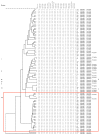Mycobacterium tuberculosis Beijing genotype is associated with HIV infection in Mozambique
- PMID: 23940801
- PMCID: PMC3737140
- DOI: 10.1371/journal.pone.0071999
Mycobacterium tuberculosis Beijing genotype is associated with HIV infection in Mozambique
Abstract
The Beijing genotype is a lineage of Mycobacterium tuberculosis that is distributed worldwide and responsible for large epidemics, associated with multidrug-resistance. However, its distribution in Africa is less understood due to the lack of data. Our aim was to investigate the prevalence and possible transmission of Beijing strains in Mozambique by a multivariate analysis of genotypic, geographic and demographic data. A total of 543 M. tuberculosis isolates from Mozambique were spoligotyped. Of these, 33 were of the Beijing lineage. The genetic relationship between the Beijing isolates were studied by identification of genomic deletions within some Regions of Difference (RD), Restriction Fragment Length Polymorphism (RFLP) and Mycobacterial Interspersed Repetivie Unit - variable number tandem repeat (MIRU-VNTR). Beijing strains from South Africa, representing different sublineages were included as reference strains. The association between Beijing genotype, Human Immunodeficiency Virus (HIV) serology and baseline demographic data was investigated. HIV positive serostatus was significantly (p=0.023) more common in patients with Beijing strains than in patients with non-Beijing strains in a multivariable analysis adjusted for age, sex and province (14 (10.9%) of the 129 HIV positive patients had Beijing strains while 6/141 (4.3%) of HIV negative patients had Beijing strains). The majority of Beijing strains were found in the Southern region of Mozambique, particularly in Maputo City (17%). Only one Beijing strain was drug resistant (multi-drug resistant). By combined use of RD and spoligotyping, three genetic sublineages could be tentatively identified where a distinct group of four isolates had deletion of RD150, a signature of the "sublineage 7" recently emerging in South Africa. The same group was very similar to South African "sublineage 7" by RFLP and MIRU-VNTR, suggesting that this sublineage could have been recently introduced in Mozambique from South Africa, in association with HIV infection.
Conflict of interest statement
Figures



References
-
- Mathema B, Kurepina NE, Bifani PJ, Kreiswirth BN (2006) Molecular epidemiology of tuberculosis: current insights. Clin Microbiol Rev 19: 658-685. doi:10.1128/CMR.00061-05. PubMed: 17041139. - DOI - PMC - PubMed
-
- Glynn JR, Whiteley J, Bifani PJ, Kremer K, van Soolingen D (2002) Worldwide occurrence of Beijing/W strains of Mycobacterium tuberculosis: a systematic review. Emerg Infect Dis 8: 843-849. doi:10.3201/eid0808.020002. PubMed: 12141971. - DOI - PMC - PubMed
-
- Bifani PJ, Mathema B, Kurepina NE, Kreiswirth BN (2002) Global dissemination of the Mycobacterium tuberculosis W-Beijing family strains. Trends Microbiol 10: 45-52. doi:10.1016/S0966-842X(01)02277-6. PubMed: 11755085. - DOI - PubMed
-
- Filliol I, Driscoll JR, van Soolingen D, Kreiswirth BN, Kremer K et al. (2003) Snapshot of moving and expanding clones of Mycobacterium tuberculosis and their global distribution assessed by spoligotyping in an international study. J Clin Microbiol 41: 1963-1970. doi:10.1128/JCM.41.5.1963-1970.2003. PubMed: 12734235. - DOI - PMC - PubMed
-
- Brudey K, Driscoll JR, Rigouts L, Prodinger WM, Gori A et al. (2006) Mycobacterium tuberculosis complex genetic diversity: mining the fourth international spoligotyping database (SpolDB4) for classification, population genetics and epidemiology. BMC Microbiol 6: 23. doi:10.1186/1471-2180-6-23. PubMed: 16519816. - DOI - PMC - PubMed
Publication types
MeSH terms
LinkOut - more resources
Full Text Sources
Other Literature Sources
Medical
Miscellaneous

